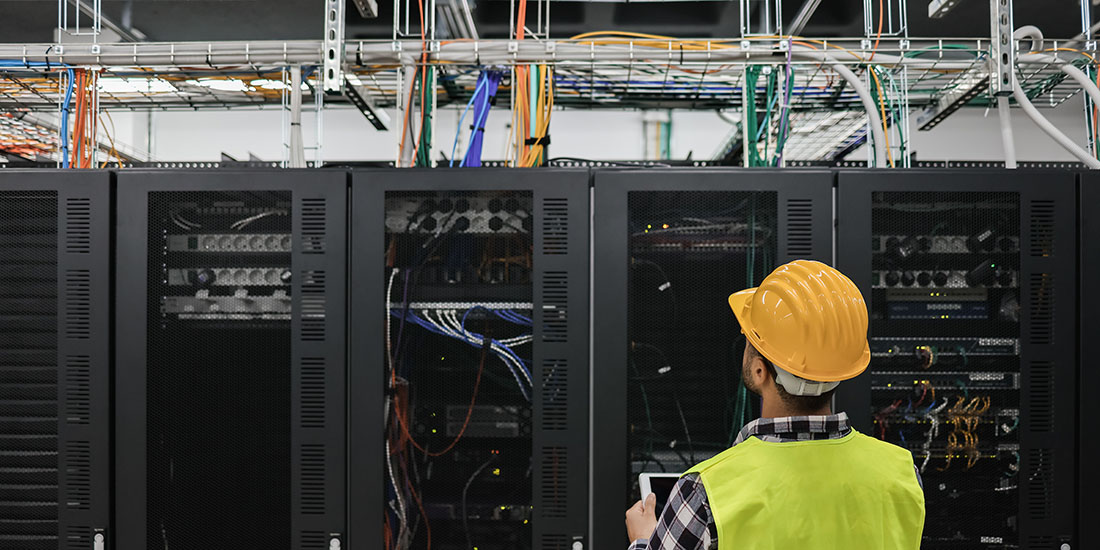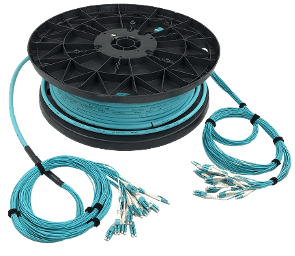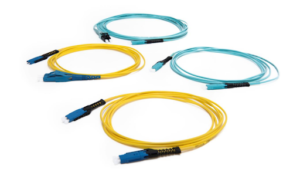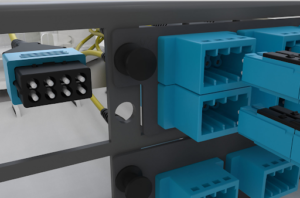
10 Nov The Future is Dense: Revolutionizing Data Centers with Fiber Optic Innovation
The recent Data Center Dynamics conference, held in Northern Virginia on November 6-7, 2023, marked a significant moment for professionals vested in the future of data centers. At the heart of the discussions was a concept that is rapidly defining the evolution of these critical infrastructures: high density. In a digital epoch characterized by exponential data growth and an unrelenting demand for faster, more efficient processing capabilities, high-density data centers are no longer a mere trend but a categorical imperative.
These sophisticated facilities are built to accommodate the burgeoning needs of big data, cloud computing, and the Internet of Things (IoT), propelling forward with the momentum of both technological advancement and commercial necessity. As we stand on the precipice of a new era in data management, it becomes essential to understand the drivers compelling this shift, the innovations in fiber optic technology making it possible, and the strategic implications for enterprises looking to scale, adapt, and thrive.
The march towards more compact, efficient, and powerful data centers is evident in the emergence of High-Density Pre-Terminated Cable Assemblies, Very Small Form Factor (VSFF) connectors, and the pioneering use of reduced diameter fiber. These advancements are not mere incremental improvements but leaps forward, redefining what is possible within the physical confines of a data center.
Below, we navigate the currents of change that are shaping high-density data centers, with a special focus on the innovative solutions such as Legrand’s Infinium acclAIM, which promises to redefine cable connectivity for a more streamlined and cost-effective future.
The Push Towards High Density: Understanding the Need
In the digital terrain, where every byte of data propels business growth, the need for high-density data centers is rooted in a blend of technological evolution and market dynamics. The ascent of cloud services, the proliferation of IoT devices, and the relentless surge of big data analytics have all conspired to create a massive influx of data. This deluge requires not just storage but swift, efficient processing. Moreover, the geographic and energy constraints impose a ceiling on physical expansion, steering the industry towards vertical scalability—doing more with less space.
The high-density data center is a paragon of this principle, designed to bolster computing power and storage capacity within a limited footprint, hence minimizing the cost per terabyte of data managed. This shift is also a response to environmental sustainability pressures, as high density equates to lower energy consumption and reduced carbon footprints, aligning with the corporate social responsibility goals of many organizations.
The inherent need for high-density data centers is also a reflection of competitive market pressures. Businesses that leverage the advantages of high-density infrastructures can realize significant cost savings, greater operational flexibility, and scalability to meet future demands. These competitive advantages are crucial in a market where latency and downtime are not tolerated, and where speed to market can dictate the success or failure of a product or service.
Revolutionizing Cabling: High-Density Solutions

The quest for high-density data centers has sparked innovation in cabling solutions, with High-Density Pre-Terminated Cable Assemblies emerging as a cornerstone technology. These assemblies are a radical departure from traditional field-terminated cabling, offering a pre-fabricated, plug-and-play solution that significantly reduces installation time and error rates. They are designed for environments where space optimization is paramount, allowing for more connections within the same rack space, thereby enabling the high-density infrastructure that modern data centers require.
The efficiency of High-Density Pre-Terminated Cable Assemblies is evident in their ability to streamline the deployment process. Data center operators can now bypass the intricate and time-consuming process of cable termination on site, which not only accelerates the setup time but also minimizes the potential for disruptions caused by installation errors. Moreover, these assemblies come with the added advantage of being factory-tested, ensuring performance reliability and system integrity from the outset.
Additionally, the modular design of these cable assemblies provides the agility needed in today’s dynamic IT environments. They facilitate rapid changes, upgrades, and reconfigurations, which are often necessitated by the fast-evolving demands of data center clients. This modularity, coupled with the density these solutions provide, places them at the forefront of cabling innovation, aligning perfectly with the needs of enterprises seeking to maximize their data center investments while remaining agile in a rapidly shifting digital landscape.
Connectivity at its Smallest: The Role of VSFF Connectors
 As the nexus of data transmission in high-density data centers, Very Small Form Factor (VSFF) connectors are critical in addressing the spatial and performance challenges posed by the modern digital deluge. Among these, the CS connector stands out for its diminutive footprint and robust design, facilitating a higher port count within the same rack unit space compared to traditional fiber optic connectors.
As the nexus of data transmission in high-density data centers, Very Small Form Factor (VSFF) connectors are critical in addressing the spatial and performance challenges posed by the modern digital deluge. Among these, the CS connector stands out for its diminutive footprint and robust design, facilitating a higher port count within the same rack unit space compared to traditional fiber optic connectors.
The CS connector, with its compact size, is engineered to support next-generation 400G networking while maintaining backward compatibility with existing duplex and simplex infrastructure. This ensures seamless integration with current systems, providing a pathway to scalability without necessitating a complete overhaul of legacy hardware.
With high-density data centers serving as the backbone of cloud computing, IoT, and 5G networks, the VSFF connectors play a pivotal role in optimizing space without compromising the signal integrity or bandwidth that these advanced applications demand. The adoption of these connectors correlates with reduced installation time and costs, as their small size negates the need for extensive cable management solutions, allowing for cleaner, more organized cable pathways.
In essence, the VSFF connectors exemplify the industry’s drive towards miniaturization, where efficiency and density go hand in hand. By enabling more connections per square inch, these connectors not only maximize real estate within the data center but also pave the way for future expansion as data throughput requirements continue to escalate. The CS connector, and its VSFF peers, are therefore indispensable in the evolution of data center design, heralding a new era where connectivity is not just about cables and connectors, but about how elegantly they can coexist in the ever-shrinking spaces of our digital landscapes.
Cutting-Edge Fiber Developments
The relentless pursuit of efficiency within data centers has driven the fiber optic industry to innovate beyond the conventional boundaries. At the forefront of this innovation are developments in fiber optic technology, particularly the advent of reduced cladding and coating diameter fibers—primarily 80 and 200 microns, respectively. These slender fibers represent a leap forward in high-density cabling, enabling a higher fiber count per unit area while minimizing the overall cable diameter.
The reduced cladding fibers, while maintaining the standard core size, allow for tighter packing in fiber bundles, which is pivotal in trunk cabling that forms the data center’s backbone. This densification does not come at the expense of signal quality or integrity. On the contrary, advancements in manufacturing precision and fiber composition ensure that these fibers can transmit data over long distances without significant loss, upholding the high performance that data center operations mandate.
The benefits of these cutting-edge fibers extend beyond their physical attributes. They are also instrumental in thermal management within cable pathways, as their reduced diameter translates to improved air flow and heat dissipation—a critical consideration in high-density racks where overheating can compromise performance and longevity.
The deployment of reduced diameter fibers is also a testament to the industry’s commitment to sustainability. With a reduced material footprint, these innovations contribute to the reduction of environmental impact, aligning with the green initiatives and sustainability goals that are increasingly becoming a corporate priority.
In a domain where every micron counts, these advancements in fiber technology are not merely incremental; they are transformative. They enable data centers to keep pace with the burgeoning data demands, while paving the way for the next generation of fiber optic infrastructure that is leaner, more efficient, and ready for the challenges of tomorrow’s data landscape.
The Rise of Small Form Factor Pluggables

In the dynamic landscape of data center technology, the emergence of small form factor pluggables (SFPs) has been pivotal. These compact, hot-swappable interface devices are revolutionizing the way data centers manage network interfaces. The trend towards smaller SFPs, such as SFP28 for 25G and QSFP28 for 100G, is a direct response to the increasing demand for higher bandwidth and greater port density.
These diminutive devices pack a powerful punch, offering data rates that were once the domain of much larger equipment. The transition to these smaller pluggables is driven by the need for efficient use of space and power without sacrificing performance. By enabling more ports per blade and thus more connections per rack, SFPs significantly enhance the capacity of data center networks.
The adoption of SFPs is not merely a matter of fitting more into less space; it’s about the agility to scale and adapt swiftly. With the ability to interchange different types of SFPs on the same platform, data centers can efficiently meet the varied and evolving connectivity needs of their clients. This flexibility is critical in an era where technological advancements are rapid and the lifespan of data center hardware is under constant pressure.
SFPs are a testament to the industry’s innovative spirit, symbolizing the shift towards modular, high-performance, and space-efficient design. They are integral to the high-density infrastructure, ensuring that as data centers grow in capability, they remain sustainable, manageable, and ready for future advancements.
Case Study: Legrand Infinium acclAIM
The Infinium acclAIM by Legrand is a trailblazing fiber solution that is setting a new standard in the realm of cable connectivity. This innovative system is designed to streamline the cabling process in high-density data centers by replacing pre-terminated cassette-based systems with direct connections, thereby facilitating a significantly simplified installation process.
Key Features
Direct Mating Breakout

The Direct Mating Breakout feature of the Infinium acclAIM is a game-changer. It removes the complications associated with alignment, pins, and polarity, allowing high-performance connectors to directly mate with twin fiber patch cords. This direct approach reduces complexity and enhances performance.
Application Defined Polarity
With Application Defined Polarity, the Infinium acclAIM system offers unprecedented flexibility. It simplifies the network infrastructure by allowing for customizable polarity, which enhances the system’s ability to adapt to various applications and facilitates efficient migrations and upgrades.
Cost Efficiency
The Infinium acclAIM solution is also a champion of cost-efficiency. By enabling up to 40% quicker patch cable installation and a 60% faster removal process, it presents a significant reduction in labor costs. Moreover, with a single connection point, the time needed for post-connection testing is halved, further driving down operational expenses.
Industry Recognition
The innovative nature of the Infinium acclAIM has not gone unnoticed in the industry. Its contribution to the fiber optic landscape was recognized by the 2022 Cabling Installation & Maintenance Innovators Awards, confirming its role as a transformative solution in data center connectivity.
Forging the Path to Next-Gen Data Centers
As we encapsulate the insights and advancements discussed, it is clear that the landscape of data center technology is undergoing a profound transformation. The progression towards high-density, efficient, and scalable data infrastructures is inevitable and essential. Innovations like the Very Small Form Factor connectors, reduced cladding fibers, and small form factor pluggables are not mere technological feats; they are the harbingers of an agile, robust, and sustainable future for data centers.
The journey towards next-generation data centers is not one to be embarked on alone. It requires the guidance of experienced professionals, who not only understand the trajectory of these advancements but also how to tailor them to the unique needs of each enterprise. As we edge closer to the zenith of data center innovation, the expertise and strategic insight offered by Fiber Guide become not just valuable, but indispensable. To participate in an OTT optical network training event by FiberGuide, point your browser to the optical network training page.
Founder and Technical Director at FiberGuide, Lecturer, Scientist and Engineer. Passionate about optical networking and information and communication technologies. Connect with me on Linkedin – https://www.linkedin.com/in/jabulani-dhliwayo-1570b5b


Sorry, the comment form is closed at this time.